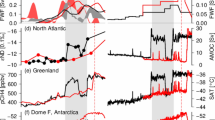Abstract
Different climate models simulate different behavior of the Atlantic meridional overturning circulation (MOC) under the same global warming scenario. We propose a plausible explanation for this and argue that a proper simulation of the present-day climate in the subpolar North Atlantic is important. This is illustrated using results from idealized global warming experiments, in which both the radiative forcing scenario and the model employed are the same, with the only major difference being the initial subpolar North Atlantic climate. The initial conditions are made progressively colder, with more extensive sea-ice cover in the northern North Atlantic.The key result is that starting from conditions which are too cold in the North Atlantic and with sea-ice that is too extensive leads to an MOC that is more stable to the radiative forcing. Furthermore, under considerably underestimated sea surface temperatures in subpolar regions, the MOC can even intensify. A reduction of freshwater flux associated with the reduction of sea-ice melt is shown to be important for such unusual behavior of the MOC. Other mechanisms are also considered, but not deemed as important in explaining published inter-model differences.













Similar content being viewed by others
References
Cubasch U, Meehl GA, Boer GJ, Stouffer RJ, Dix M, Noda A, Senior CA, Raper S, Yap KS et al. (2001) Projections of future climate change. In: Climate change 2001. The scientific basis. Contribution of working group I to the third assessment report of the intergovernmental panel on climate change, Cambridge University Press, Cambridge 44, pp 525–582
Dixon KW, Delworth TL, Spelman MJ, Stouffer RJ (1999) The influence of transient surface fluxes on North Atlantic overturning in a coupled GCM climate change experiment. Geophys Res Lett 26: 2749–2752
Fanning AF, Weaver AJ (1997) On the role of flux adjustments in an idealized coupled climate model. Clim Dyn 13: 691–701
Gent PR (2001) Will the North Atlantic Ocean thermohaline circulation weaken during the 21st century? Geophys Res Lett 28: 1023–1026
Gent PR, McWilliams JC (1990) Isopycnal mixing in ocean general circulation models. J Phys Oceanogr 20: 150–155
Gregory JM (2000) Vertical heat transports in the ocean and their effect on time-dependent climate change. Clim Dyn 15: 501–515
Hall MM, Bryden HL (1982) Direct estimates and mechanisms of ocean heat transport. Deep-Sea Res 29: 339–359
Hughes TMC, Weaver AJ (1994) Multiple equilibria of an asymmetric two-basin ocean model. J Phys Oceanogr 24: 619–637
Latif M, Roeckner E, Mikolajewicz U, Voss R (2000) Tropical stabilization of the thermohaline circulation in a greenhouse warming simulation. J Clim 13: 1809–1813
Manabe S, Stouffer RJ (1993) Century-scale effects of increased atmospheric CO2 on the ocean-atmosphere system. Nature 364: 215–218
Mikolajewicz U, Voss R (2000) The role of the individual air-sea flux components in CO2-induced changes of the ocean’s circulation and climate. Clim Dyn 16: 627–642
Neelin JD, Dijkstra HA (1995) Coupled ocean-atmosphere interaction and the tropical climatology, part I: the dangers of flux-correction. J Clim 8: 1343–1359
Roemmich D, Wunsch C (1985) Two transatlantic sections: meridional circulation and heat flux in the subtropical North Atlantic Ocean. Deep-Sea Res 32: 619–664
Saenko OA, Weaver AJ, Schmittner A (2003) Atlantic deep circulation controlled by freshening in the Southern Ocean. Geophys Res Lett 30: 1754 doi:10.1029/2003GL017681
Thorpe RB, Gregory JM, Johns TC, Wood RA, Mitchell JFB (2001) Mechanisms determining the Atlantic thermohaline circulation response to greenhouse gas forcing in a non-fluxadjusted coupled climate model. J Clim 14: 3102–3116
Tziperman E (2000) Uncertainties in thermohaline response to greenhouse warming. Geophys Res Lett 27: 3077–3080
Weaver AJ, Eby M, Wiebe EC et al (2001) The UVic earth system climate model: Model description, climatology and application to past, present and future climates. Atmosphere-Ocean 39: 361–428
Wiebe EC, Weaver AJ (1999) On the sensitivity of global warming experiments to the parametrisation of sub-grid scale ocean mixing. Clim Dyn 15: 875–893
Acknowledgements
We would like to thank Peter Gent and an anonymous reviewer for helpful comments. We are grateful for research support from the Canadian Climate Change Action Fund, Natural Sciences and Engineering Research Council of Canada, and the Canadian Foundation for Climate and Atmospheric Sciences (through the Canadian CLIVAR program). We also would like to thank E. Wiebe for assistance. A. Weaver acknowledges release time provided by the Killam Foundation and Canada Research Chair Program.
Author information
Authors and Affiliations
Corresponding author
Rights and permissions
About this article
Cite this article
Saenko, O.A., Eby, M. & Weaver, A.J. The effect of sea-ice extent in the North Atlantic on the stability of the thermohaline circulation in global warming experiments. Climate Dynamics 22, 689–699 (2004). https://doi.org/10.1007/s00382-004-0414-0
Received:
Accepted:
Published:
Issue Date:
DOI: https://doi.org/10.1007/s00382-004-0414-0




